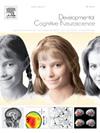与酒精有关的停电与大脑结构发育减弱之间关系的纵向研究。
IF 4.6
2区 医学
Q1 NEUROSCIENCES
引用次数: 0
摘要
目的:酒精相关性昏厥(ARBs)在青少年和新成人中很常见。ARB也可能表明与酒精相关的神经认知发生了持续性变化。本研究将 ARBs 作为大脑结构发育改变和相关认知关联的预测因子进行了探讨:纵向生长曲线模型估计了美国国家青少年酒精与神经发育联合会(NCANDA)研究参与者(n = 800,其中 213 人终生服用 ARB)6 年的脑容量轨迹。在控制人口统计学和总体酒精使用情况的同时,对与酒精相关的认知变化区域的脑容量增长进行了预测分析。事后分析检验了抗逆转录酶抑制剂是否调节了大脑形态与认知之间的关系:结果:与总体饮酒情况相比,ARBs 可明显预测在特定时间点纺锤形回和海马体积的减小。不使用抗逆转录酶抑制剂的酗酒者在较早和较晚的时间点分别会明显预测到纺锤形回和海马体积发育的减弱。尽管与记忆相关区域的发育发生了改变,但ARBs并没有明显缓和脑容量与认知表现之间的关系:结论:ARBs和总体饮酒情况预示着纺锤形回和海马在不同时间点的大脑发育发生了改变,这表明ARBs是年轻饮酒者神经认知风险的独特标志。本文章由计算机程序翻译,如有差异,请以英文原文为准。
A longitudinal study of the relationship between alcohol-related blackouts and attenuated structural brain development
Purpose
Alcohol-related blackouts (ARBs) are common in adolescents and emerging adults. ARBs may also be indicative of persistent, alcohol-related neurocognitive changes. This study explored ARBs as a predictor of altered structural brain development and associated cognitive correlates.
Methods
Longitudinal growth curve modeling estimated trajectories of brain volume across 6 years in participants from the National Consortium on Alcohol and Neurodevelopment in Adolescence (NCANDA) study (n = 800, 213 with lifetime ARB history). While controlling for demographics and overall alcohol use, ARB history was analyzed as a predictor of brain volume growth in regions associated with alcohol-related cognitive change. Post hoc analyses examined whether ARBs moderated relationships between brain morphology and cognition.
Results
ARBs significantly predicted attenuated development of fusiform gyrus and hippocampal volume at unique timepoints compared to overall alcohol use. Alcohol use without ARBs significantly predicted attenuated fusiform and hippocampal growth at earlier and later timepoints, respectively. Despite altered development in regions associated with memory, ARBs did not significantly moderate relationships between brain volume and cognitive performance.
Conclusion
ARBs and overall alcohol use predicted altered brain development in the fusiform gyrus and hippocampus at different timepoints, suggesting ARBs represent a unique marker of neurocognitive risk in younger drinkers.
求助全文
通过发布文献求助,成功后即可免费获取论文全文。
去求助
来源期刊

Developmental Cognitive Neuroscience
NEUROSCIENCES-
CiteScore
7.60
自引率
10.60%
发文量
124
审稿时长
6-12 weeks
期刊介绍:
The journal publishes theoretical and research papers on cognitive brain development, from infancy through childhood and adolescence and into adulthood. It covers neurocognitive development and neurocognitive processing in both typical and atypical development, including social and affective aspects. Appropriate methodologies for the journal include, but are not limited to, functional neuroimaging (fMRI and MEG), electrophysiology (EEG and ERP), NIRS and transcranial magnetic stimulation, as well as other basic neuroscience approaches using cellular and animal models that directly address cognitive brain development, patient studies, case studies, post-mortem studies and pharmacological studies.
 求助内容:
求助内容: 应助结果提醒方式:
应助结果提醒方式:


